-
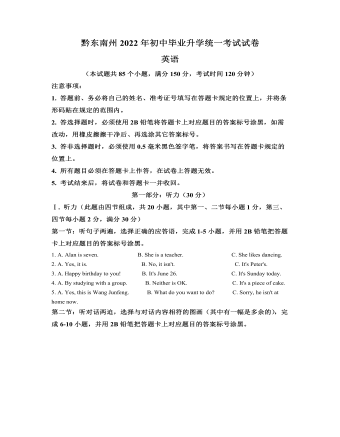
2022年贵州省黔东南州中考英语真题(解析版)
Electric cars may seem like a recent invention,but they have been around for years. In the early 1900s, there were ___16___ electric cars on the road than gasoline(汽油)cars,because at that time, gasoline was expensive compared with other fuels(燃料)
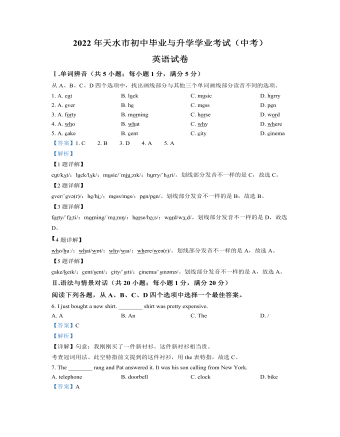
2022年甘肃省天水市中考英语真题(解析版)
My mum and dad bought a nice, big turkey a fewdays before Thanksgiving. ___29___was proud of herself as she got it for a good price. ___30___ Thanksgiving, Mum got the turkey out of thefridge.
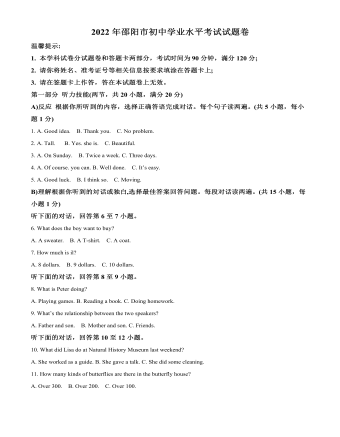
2022年湖南省邵阳市中考英语真题 (解析版)
An unexpected thing happened in the ____11____ of my eleventh year. Thehome I had ____12____inwas burned to the ground in the middle of the night. ____13____ , mymom, dad, grandma, brothers and I escaped(幸免于难).
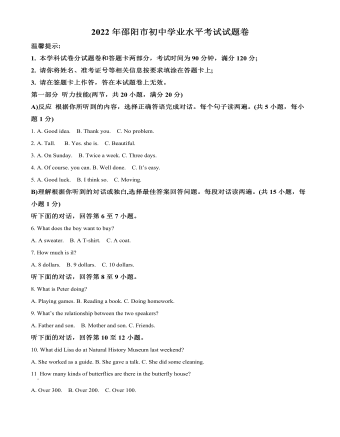
2022年湖南省邵阳市中考英语真题 (原卷版)
“We thankall the Chinese people for their support and encouragement. Our thanks also goto our workmates who took part in the mission (任务) and worked with us allthe time,” Zhai said to the reporter after he landed on the ground. “It is thepower and strength of our country that built the high-flying space station. Iam proud of our great motherland.”

2022年湖南省湘潭市中考英语真题(原卷版)
Fiveyears ago, Jennifer, a girl from Australia, came to Xiangtan University tostudy Chinese. There she fell in love with Chinese culture and met her husband,who is a local (当地的) young man. They got married after she finishedher study. Since then, she has started her new life in Xiangtan City.
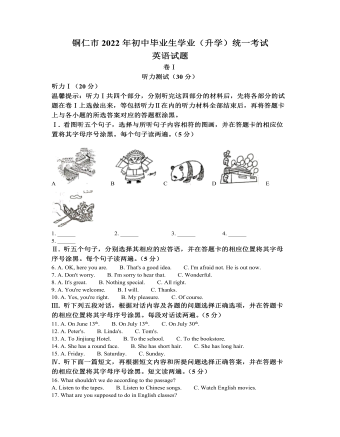
2022年贵州省铜仁市中考英语真题(解析版)
I’m glad to receive your letter and know yourunforgettable(难忘的)experience.Now I’d like to share mine. Last Friday, I was cleaning my room and found anold photo in a drawer. While I was looking at it, the ___16___ memory of that day came back to me.
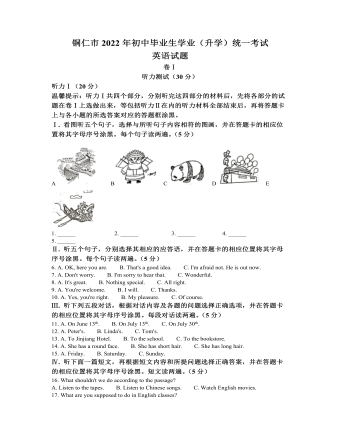
2022年贵州省铜仁市中考英语真题(原卷版)
Bill doesn’t like doingfamily housework at all. He likes to play with his friends in the park.Bill asks his four friends about their housework.Bill: What do you have to do at home, Dan?
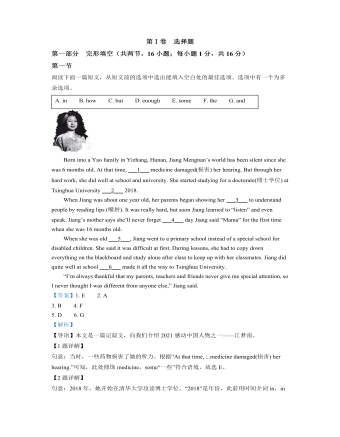
2022年贵州省贵阳市中考英语真题(解析版)
Paper cutting or tearing is a cultural traditionin China. For centuries, it has been passed down from one generation(一代人) tothe next, especially from mothers to daughters. This beautiful art created byskillful artists is used to decorate(装饰) doors, ceilings, and bedsin people’s homes, or at celebrations such as birthdays and weddings.
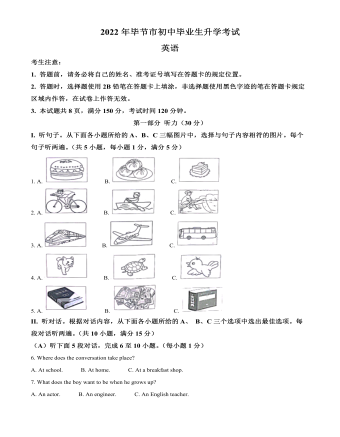
2022年贵州省毕节市中考英语真题(解析版)
Mr. Zhang was a cook in Canada. He ___11___ in Guangzhou, and he learned to cook in HongKong. He moved to Canada for work when he was 26 years old. Everything was goodtill COVID-19(新冠病毒)brokeout. Last year, he returned to China because the economy(经济)inCanada began ___12___down.
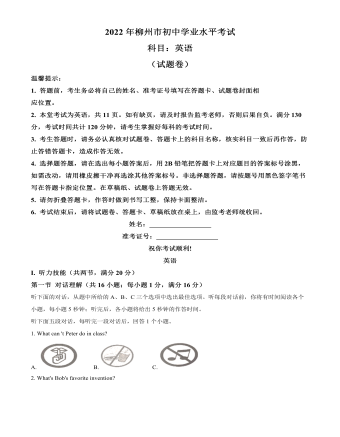
2022年湖南省郴州市中考英语真题(原卷版)
A passenger told an air hostess(空姐)thathe needed a cup of water to take his medicine when the plane just took off. Shetold him that she would bring him the ___11___ in ten minutes.
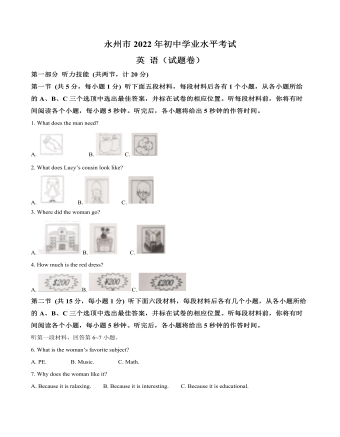
2022年湖南省永州市中考英语真题(原卷版)
Parentsand children often face the challenges of money. Common topics include settingpocket money, learning to save, and deciding to buy expensive things. The goalof most parents is to teach their kids how to deal with money wisely. The goalof most kids is getting money to spend. How can families achieve these goals?
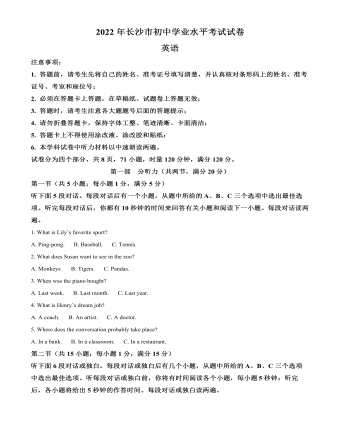
2022年湖南省长沙市中考英语真题(原卷版)
In ourdaily lives, we are often given some boring or tiring tasks. What’s in yourmind when your mom tells you to clean the floor? Have you ever wanted tocomplain(抱怨)? I think most people have.

2022年湖南省郴州市中考英语真题(解析版)
Apassenger told an air hostess(空姐)that he needed a cup of water to take hismedicine when the plane just took off. She told him that she would bring himthe ___11___ in ten minutes.
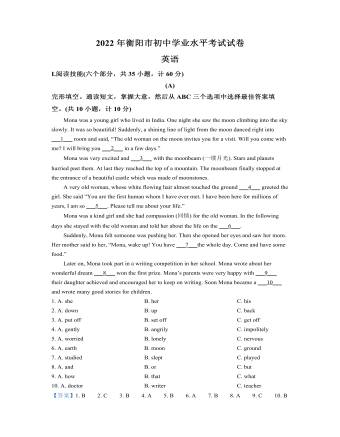
2022年湖南省衡阳市中考英语真题(解析版)
Some schools have organized too many tests thatare too difficult. As a result, students have to study hard all the time andthey have been under a lot of stress. It has been harmful to students’ mental (心理的)and physical health and it must be changed.
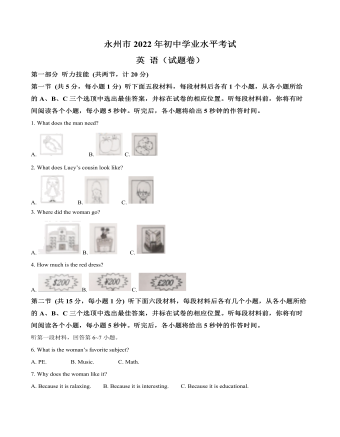
2022年湖南省永州市中考英语真题(解析版)
Parents and children often face the challengesof money. Common topics include setting pocket money, learning to save, anddeciding to buy expensive things. The goal of most parents is to teach theirkids how to deal with money wisely. The goal of most kids is getting money tospend. How can families achieve these goals?
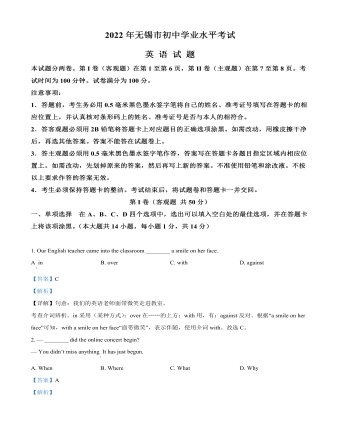
2022年江苏省无锡市中考英语真题(解析版)
Jared ___15___ to stay at home, but his mom sent him anyway.He had to sit next to Jessica. At reading time, Mrs. Thomas asked Jared toread. Reading aloud always made Jared ___16___ . As he picked up the book, his hands shook.“He can’t read,” Jessica said. “I didn’t call on you, did I?”
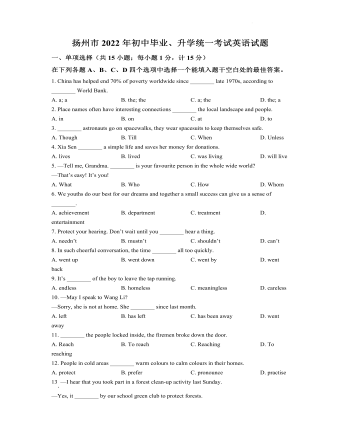
2022年江苏省扬州市中考英语真题(原卷版)
Every month, Julia and her cousins would go forthe big family meal at their grandparents’ house. On each visit, their grandpawould give them a few coins. Then all the children would run off to buy sweets.One day, he gathered the children together.

2022年江苏省常州市中考英语真题(解析版)
Russia’s skating silver medalist AlexandraTrusova, 17, amazed the world with five quadruple jumps (四周跳)during free skate at the Beijing Winter Olympics. No other woman has everfinished five quadruple jumps in an Olympic competition.
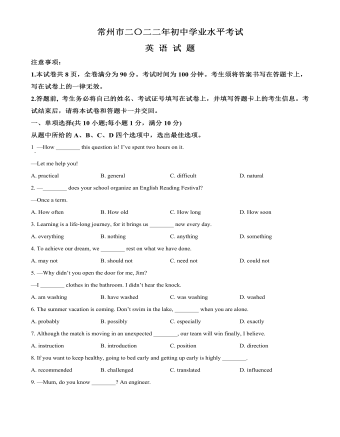
2022年江苏省常州市中考英语真题(原卷版)
At 9 a.m. , he drives to primary schools and middle schools in Xi’an, ShaanxiProvince, to teach students about Shaanxi kuaiban. It is a traditional Chineseform of storytelling to the rhythm(节奏) of bamboo clappers(响板), whichthe art form is named after. Sometimes, he helps students prepare forcompetitions. Usually, his classes run until about 6. p.m. , and then hereturns home to prepare classes for the next day.
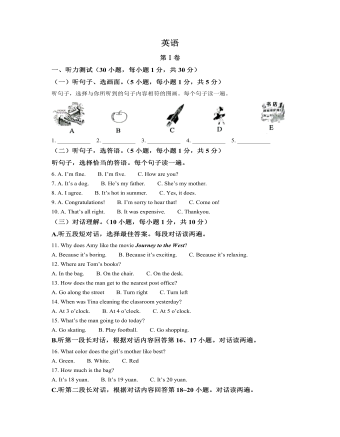
2022年广西贺州市中考英语真题(解析版)
Flying kites Kites have quite a long history. The earliest kites were made ofwood, instead of paper. Nowadays, the three most famous kites are the Beijingkite, Tianjin kite, and Weifang kite. And they are quite different from eachother. For example, the swallow-shaped kite is a well-known Beijing style.





















